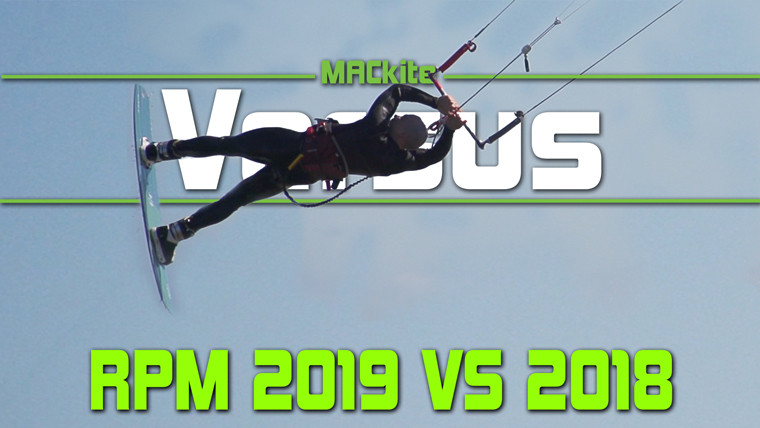2019 Slingshot RPM VS 2018 - Complete review
A review of the 2019 Slingshot RPM
Slingshot is hyping up the new RPM hard and their videos are hilarious. However, they do leave some questions at hand. Namely, what can you expect from the new RPM, and how does it differ from the original? More importantly, are they fixing something that's not broken to get it back on your radar? We'll cover all of that and more in this complete review. If I had to sum up the new RPM in three words it would be, "smooth, consistent and grunty", but that doesn't even begin to tell the entire story.
Let's tackle this review point-by-point on various aspects of the kite. The good, the bad, and what to expect from each year’s version.
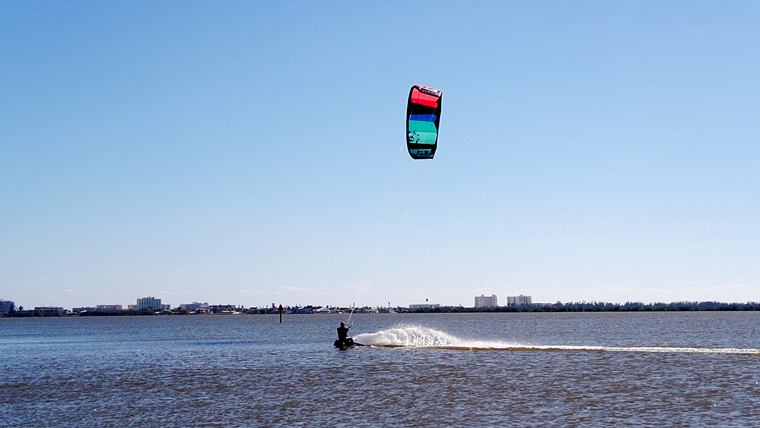
The 2019 Slingshot RPM has more grunt
Wind Range
First up is the wind range. The new RPM has a larger wind range. The original RPM liked power and thrived in the mid to high end of its range. The new RPM still has great performance on its high end, but the low end has taken a massive leap. It's the first thing that pops out while testing the kite. With the original, in lighter winds we would have to sine the kite and turn it actively. This was not the case on the new RPM. I don't believe it matches the low end on the Rally, but it is a step closer.
I checked some of the wind charts and both kites are rated for the same wind range. This is deceptive because, while they will work in the same range, the 2019 RPM will require a great deal less effort in lighter winds. You will have to work the 2018 a little to match the new RPM's wind range.
This means you can get a wider range out of your RPM for less work. I was always able to ride the original 10 meter RPM like a crossover freestyle kite. Which is to say, aggressively, to generate the board speed I needed. This varied in difficulty from size to size. With the original 12 meter it was more difficult but doable. On the new RPM 12 meter, we found when there was a hole in the wind, we didn't need to be as proactive. When it got light we sined it more like a freeride kite with smooth, large power strokes. It took a great deal less effort to ride upwind or get the power and speed needed for tricks. So, effectively:
Old RPM
- Reduced low-end
- Flies similar to a freestyle kite
- Requires a proactive rider to maximize performance
- Easy for new riders to learn on
New RPM
- Flies like an all-around kite
- Requires less rider feedback
- Autopilot feel, smooth grunty low-end
- Easier for new riders to learn on
How does the wind range stack up to other kites?
In the video, I claimed it didn't quite have the low end of the Rally. I was mistaken. After uploading it, I started to question this. The kite did seem to have a ridiculously good wind range, especially for the range of conditions we tested in. I checked the official charts and sure enough, the new RPM and the 2019 Rally are rated for the same wind speeds now. This means the RPM is leading the charge in regards to most other kites. It's actually on par with a Switchblade. I'll have both of these kites with me next week while filming a new playlist of Ride with Blake. We'll test these back to back to verify. Stand by for an update in March.
Final thoughts on the wind-range:
We loved the new low-end on this kite. Paired with the smoother power delivery and consistent feedback, it is a better tool. An experienced rider wouldn't mind either model. But, we found it made our gusty session way more enjoyable from cruising to sending it or unhooking.
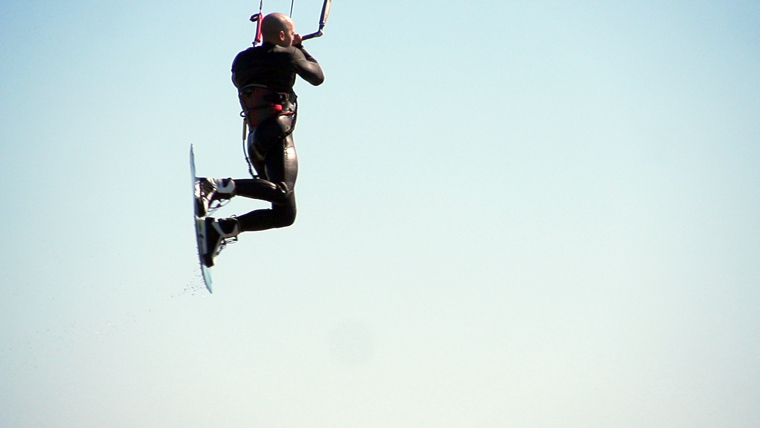
The 2019 Slingshot RPM is easier to jump with, not better
Jumping
Before I dive into this I want to give a disclaimer. I'm not the type of reviewer to tell you that the newest model is better just because it's new. I will share my opinion and experience when testing kites. In fact, MACkite carries both, so my aim is to help you decide which model is right for you. With that said, the jumping was different between these kites. The new RPM does jump easier. In the video I said "better", but in retrospect I should have used the word "easier". The original had a great deal of potential for air, but it required a more skilled rider to maximize the potential for height.
Old RPM
The old RPM wasn't famous for jumping. That's what the Rally is for. It took more timing to get your pop right and you had to pull the trigger at the right time. For more airtime, you had to hold that bar in all the way for a lofty jump. Not a big deal if you're used to it, but somewhat annoying if you ride kites like the Rally or the Duotone Evo. This is what I mean by the new RPM is easier. Timing is now out of the equation.
Like a lot of freestyle kites, the old RPM would come down fast and catered to an aggressive rider. It was fun to fly and reminded me of the freestyle kites that I prefer. In fact, I often thought about crossing over to the RPM as it was a bit of a rare gem compared to other models out there. The RPM of any year is a more user-friendly freestyle crossover kite like the FX or the Dice.
New RPM
The new RPM has an autopilot feel. Jumping is effortless and requires very little, if any, rider feedback. A less skilled rider can jump as easily as a skilled rider could on the original RPM. The jumps are smoother, loftier, and you don’t have to pull the bar in all the way and hold it there to get good air.
When it came to hooked-in tricks, I’ve never had more fun on an RPM. Something else that stood out was the feedback. It was consistent and I always felt exactly where the kite was at any point during the trick. The old RPM was so responsive, sometimes I'd loop it mid-roll by mistake on the smaller sizes. This is why I should have said jumping is easier rather than better in the video. Some riders prefer a kite that takes more timing like the original RPM, while others want things to feel like they are on autopilot. This is completely subjective and up to you. Admittedly, I prefer the new model myself.
How does it stack up to other kites?
The new RPM jumps more like a Cabrinha Switchblade or the Slingshot Rally. It's more lively yet less lofty. It still sits between those two kites and explosive freestyle kites like the Cabrinha FX or the Duotone Dice. The original was somewhat on par with the FX or Dice but not as explosive.
Final thoughts on jumping:
Each kite caters to the same rider, but with a different approach. The new RPM is like the old RPM but it is more friendly to newer riders or weekend warriors. Meaning, a skilled rider could get as much air on the old RPM. It's a lot easier and something like 10% loftier on the new RPM.
- If you like complete control, speed and an aggressive jump, the classic RPM is where it's at.
- If you want effortless air, maximum hang time and ease of use, you'll want the new RPM
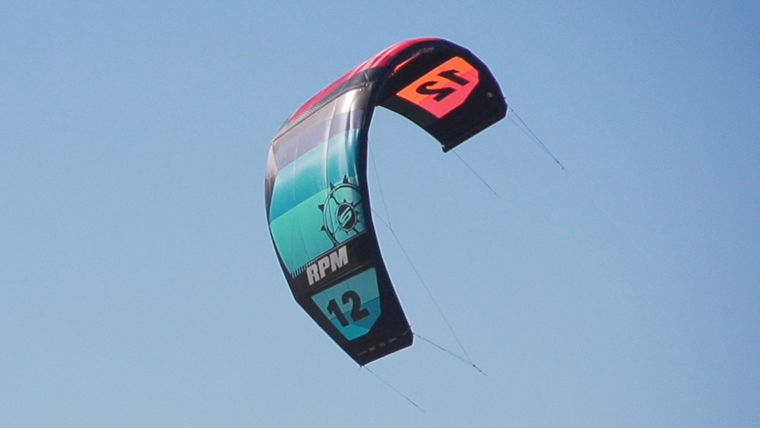
The larger bridle makes for a more stable kite
Stability
Remember my "unbiased" disclaimer? The new RPM is more stable. I can only assume this is due to the new canopy and bridle design. We tested this kite in some smoother wind as well as gusty winds. It's not as smooth as a Rally, but it does bridge the gap between the old RPM and the current Rally.
Old RPM
You might be noticing a trend here. The old RPM is the original crossover freestyle kite that stands in a category of its own. What I mean is, it shares many of the traits I often talk about when comparing freeride kites to freestyle kites. In this case, the old RPM caters to a more advanced rider but is easier to use than most freestyle kites.
This is why you would often see pro freestyle riders using it in competition as often as students learning on it in schools. It was really unique in that sense. While it was easy to use, it was not as easy as non-competitive all-around kites like the Rally. Edging and board speed are very important for loading and popping.
Sending it, riding upwind and keeping the kite stable. Over time, every brand began to develop their own version of the RPM, most a step closer to C kites.
New RPM
The new RPM flies like an all-around kite. With the new bridle and shape, you can expect a more forgiving ride and autopilot feel. Now, don't mistake this forgiving feel for a less direct kite. I'll touch on that point more in a moment. The new RPM handles gusty wind better and makes for a more forgiving ride.
It's more akin to a Cabrinha Switchblade or the Slingshot Rally in regards to stability, not feel. For those of you that like having control over your kite, the new RPM does cater more to the active rider than a Rally. Unless you demand the fastest kite, chances are you'll enjoy the new improvements.
The new RPM stands out as, not only is it stable, it maintains a direct feel regardless of the larger bridle. It's not going to be as fast or direct as the original RPM, but the tension and feedback remains even throughout the turn.
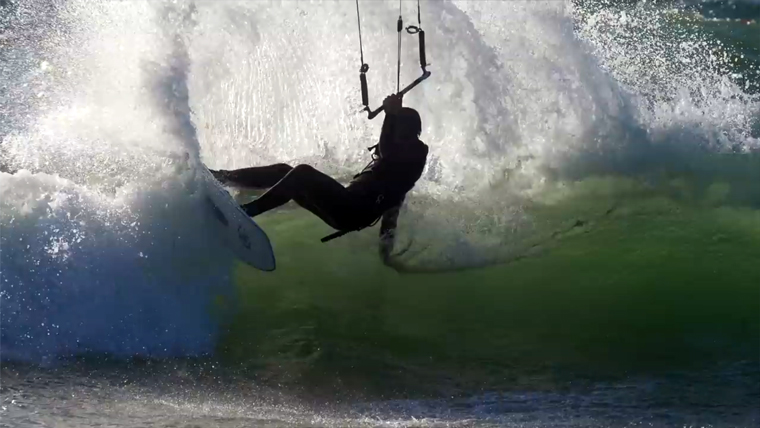
The Slingshot SST is better in the waves but the RPM works well enough for most riders
Kite Surfing Waves
This is an interesting point. No generation of the RPM has been spectacular in the waves. Before I became accustomed to wave-specific kites I loved the original RPM in the waves. Over the years, I still use it in small to medium waves, but I do have a better perspective on where it stacks up. Here's what I've settled on. Both will work, but you'll have to change your style. Here's what I mean:
Old RPM
The original RPM was very fast, it looped if you blinked at it, and there wasn't much low end. This made it one of my go-to wave kites. It catered to an active wave rider who enjoys riding a wave with kite power as much as wave power. You could loop the kite to charge into better sections of the wave.
The lack of low end made it great as it was rare to get pulled off the wave. All that said, it was a better tool for medium and small waves. It was by no means a specialty wave kite. You also didn't want to drop it in the waves as it could invert in those conditions.
New RPM
With the new RPM, you get many of the the traits you loved, but it does have more low end. This means you won't need to ride it as aggressively in the the waves. It's going to feel more like a freeride kite in this sense. This might be good news if you're a rider who doesn't like to actively fly your kite in waves. If you are an active kitesurfer, I would size down to taper off the low end. Albeit, this is a tip for more for intermediate wave riders. The new RPM does have a better relaunch so you can drop it with more confidence. All that said, any dedicated wave kite is a better choice here.
Kiteloops
Kiteloops were a bit different. The main difference here is the timing. With the old RPM, downloop transitions are effortless. You could do it with one hand in the middle of the bar. The kite was twitchy and always ready for a loop as it was so aggressive but lacked grunt. The new RPM has a slight delay when pulling the trigger for a loop. It has a more consistent, grunty pull throughout the loop as well.
I'll be working on some new videos with Blake Olsen in three weeks. I'll make a point to include his notes on this point after our shoot. We're working on some new kite loop videos and I have a feeling he will have some strong insights into this kite. Stand by for an update.
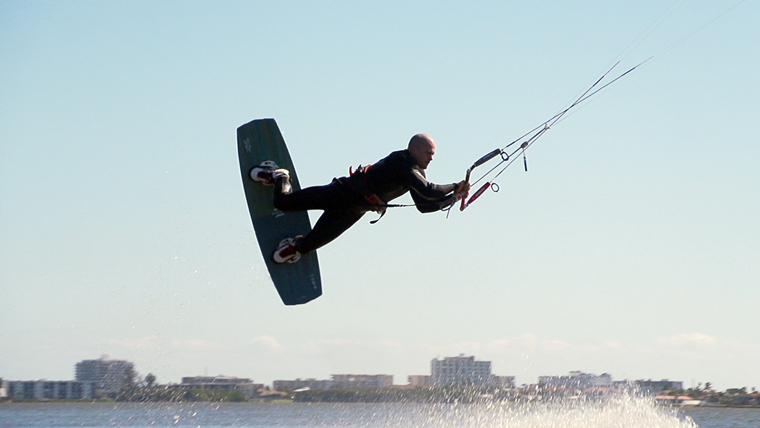
Steve Lee testing the 2019 RPM
Unhooked
I'm sure many of you who flew the original RPM are wondering how it's going to perform unhooked with all the new changes. In fact, a lot of the videos are a little confusing. They modified the canopy to a wider, deeper C, making it sound like it took a step towards the Fuel. Yet all the points we've covered show that it's actually taken a step in the user-friendly freeride direction.
That's not exactly the case. The direct feel and consistent, even bar pressure felt more like a Fuel. While it has the user-friendly traits of an all-around kite, it's still excellent for unhooking. We noticed while riding in the recommended wind range that it unhooks like most freestyle kites, kites like the Cabrinha FX or Duotone Dice. It's powerful and not as explosive, but the release is smoother than those kites.
It has more consistent bar pressure than other models and it doesn't rip your arms off. It's a great tool for a kiteboarder looking to progress in freestyle or wakestyle. The smooth, predictable pop and softer pull will help with style and handle passes.
At the top end, or when you are a bit overpowered, it feels more like unhooking on a Cabrinha Switchblade or a Rally, meaning it's going to start pulling you through the trick and you might get stretched a bit more. It may take a touch more strength in these conditions. You also have to rotate and land more downwind for handle passes. For you this means, most of the the time, it will perform like an easier-to-use freestyle kite. When the wind picks up or gets gusty you can adapt and ride like you would on an an all-around kite. The big takeaway here is the new RPM is more consistent in every sense of the word.
This is due to the "load shift" mentioned in all the product videos. I don't care to use a marketing buzzword like this, but it's actually something we loved about the new RPM. The even pressure between all the lines made it effortless to control the kite. I don't think I've ever had more confidence feeling where my kite was in the sky mid-trick. It was actually a new feeling for me, despite having tested so many kites. The consistent, balanced bar pressure throughout the trick was useful. We noticed this benefit when riding hooked in or unhooked, and it is unique to the RPM.
Now don't be mistaken, the old RPM has many world titles under its name. The biggest difference here is, when unhooked, the new model is less twitchy and more consistent. It caters to entry level kiteboarders, not only pros and weekend warriors. That said, aside from unhooking, the old RPM was a school favorite. It's a kite many new kiteboarders learn on.
How does it compare to other kites?
The old RPM and the new RPM fit into a category of their own. If you want pure pop and slack, you'll want a crossover kite like the FX, the Dice, the Dash or you can go really hardcore and pick up a Slingshot Fuel. Personally, I'm really impressed with the new RPM. The good low end power, the feedback and the mild yet consistent, explosive pop was a welcomed change from last year's model. If you're new to unhooking or working on improving your freestyle, you will not be disappointed with either generation. If you prefer something more advanced or aggressive, go for a freestyle kite. Either way, the RPM will not hold you back. Have you seen the team that rides on these?
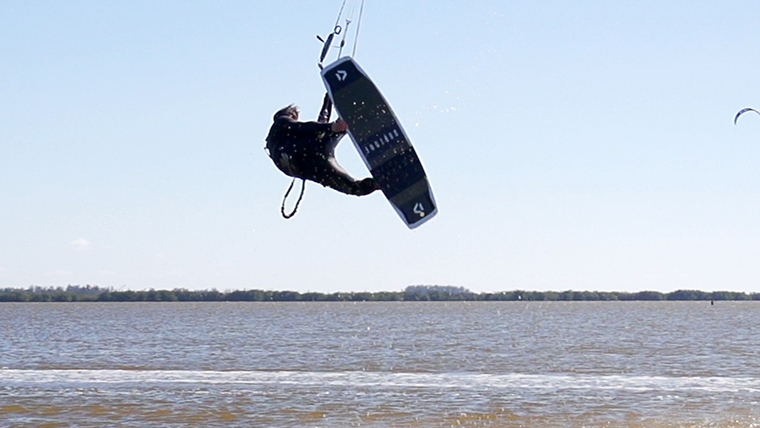
Rygo throwing a Backroll Stalefish on the new RPM
Summary
The original RPM was the first of its kind. It lead the the charge for modern crossover freestyle kites. Yet, it never got caught up in the hype as it was ahead of its time. It was the fastest of the the three-strut kites, the most responsive and versatile. Pro riders took it to competition, and new riders learned to ride on it.
At the end of the day, with it having been around so long, everyone was simply bored hearing about it. There was nothing wrong with the original RPM. That said, I'm proud of Slingshot for this new campaign since the RPM wasn't getting the hype as it deserved.
So, does the new RPM live up to the hype? Yes it does. It's more balanced, modern, versatile and user-friendly. You do trade off some speed and responsiveness. This is in exchange for a great deal of stability, low end power, and better jumping. Unhooked, we prefer the consistent, stable feel. We found it easier to progress as the kite was less twitchy. Either way you go, the RPM is still a stand-out kite that fits into a category of its own.
Either generation of the RPM sits between freeride kites and freestyle kites, making it the most unique hybrid and longest-standing hybrid kite available. The 2019 model has noticeable benefits and fewer tradeoffs than the original.
"Versus" is an open forum and we welcome your feedback. This is our subjective experience from testing the new kite. I wanted to write this one up with the feedback from our team rider Steve Lee, as he had valuable insights riding the Fuel and other wakestyle kites. This is our take on this kite.
That said, we'd love to hear what you have to say about either kite. Share your experiences and insights in the comment section of our YouTube video.
In the video, I mentioned I would include the v/log Steve and I made while testing the new RPM.
Until next time, this has been Rygo and I'll catch you later on Versus.
 Ryan (Rygo) Goloversic
Ryan (Rygo) Goloversic
Just a dude from a kite shop testing all the gear one session at a time.
Many people dream of quitting their job, traveling the world and pursuing their passions. Rygo is one of those people who pulled the trigger. A few years into a postal career, he decided to change everything and travel as a kiteboarder, freelance videographer & writer. His mission is to help people and share the stoke. Get out there and kite!
Producer of: Ride with Blake I Sessions I Versus I Destinations I Foil Fridays
Recent Posts
-
North Navigator Pro Quick Release | How to Swap Yours Out With Ease
What You Need Before starting the replacement process, ensure you have all the necessary t …18th Apr 2024 -
Foil Drive | Essential Tips to Supercharge Your First Session
The Foil Drive makes your foiling life easier. You'll get up easier and catch more waves, …17th Apr 2024 -
2024 Duotone Slick Wing Review | What's New in This Year's Model?
The Duotone Slick has been a favorite of many for several years. Pros love it for its speed, …15th Apr 2024

